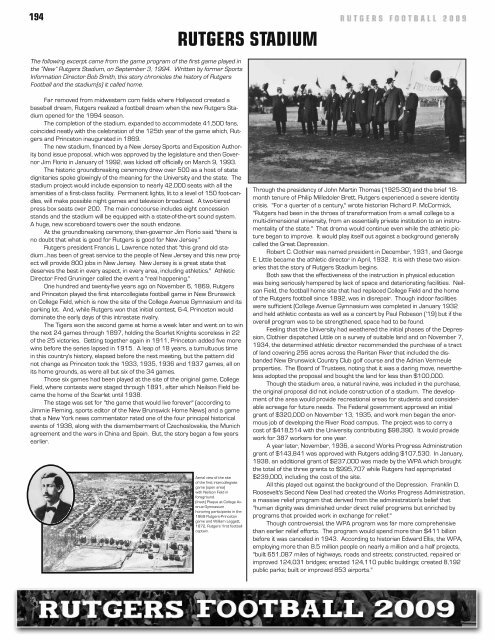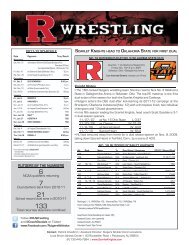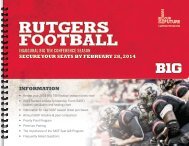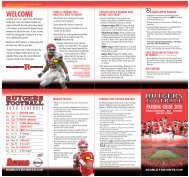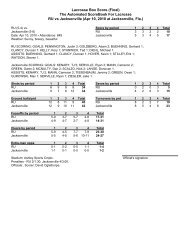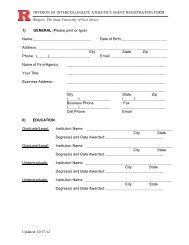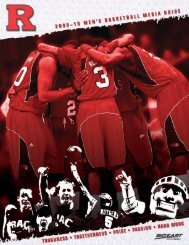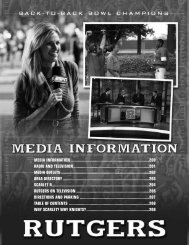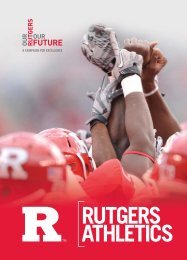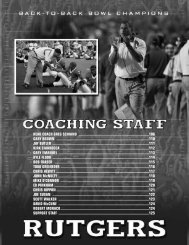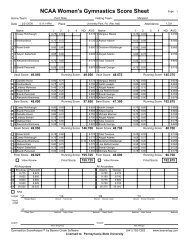letterwinners - Rutgers
letterwinners - Rutgers
letterwinners - Rutgers
You also want an ePaper? Increase the reach of your titles
YUMPU automatically turns print PDFs into web optimized ePapers that Google loves.
194<br />
The following excerpt came from the game program of the first game played in<br />
the “New” <strong>Rutgers</strong> Stadium, on September 3, 1994. Written by former Sports<br />
Information Director Bob Smith, this story chronicles the history of <strong>Rutgers</strong><br />
Football and the stadium(s) it called home.<br />
RUTGERS STADIUM<br />
Far removed from midwestern corn fields where Hollywood created a<br />
baseball dream, <strong>Rutgers</strong> realized a football dream when the new <strong>Rutgers</strong> Stadium<br />
opened for the 1994 season.<br />
The completion of the stadium, expanded to accommodate 41,500 fans,<br />
coincided neatly with the celebration of the 125th year of the game which, <strong>Rutgers</strong><br />
and Princeton inaugurated in 1869.<br />
The new stadium, financed by a New Jersey Sports and Exposition Authority<br />
bond issue proposal, which was approved by the legislature and then Governor<br />
Jim Florio in January of 1992, was kicked off officially on March 9, 1993.<br />
The historic groundbreaking ceremony drew over 500 as a host of state<br />
dignitaries spoke glowingly of the meaning for the University and the state. The<br />
stadium project would include expansion to nearly 42,000 seats with all the<br />
amenities of a first-class facility. Permanent lights, lit to a level of 150 foot-candles,<br />
will make possible night games and television broadcast. A two-tiered<br />
press box seats over 200. The main concourse includes eight concession<br />
stands and the stadium will be equipped with a state-of-the-art sound system.<br />
A huge, new scoreboard towers over the south endzone.<br />
At the groundbreaking ceremony, then-governor Jim Florio said "there is<br />
no doubt that what is good for <strong>Rutgers</strong> is good for New Jersey."<br />
<strong>Rutgers</strong> president Francis L. Lawrence noted that "this grand old stadium...has<br />
been of great service to the people of New Jersey and this new project<br />
will provide 800 jobs in New Jersey. New Jersey is a great state that<br />
deserves the best in every aspect, in every area, including athletics." Athletic<br />
Director Fred Gruninger called the event a "real happening."<br />
One hundred and twenty-five years ago on November 6, 1869, <strong>Rutgers</strong><br />
and Princeton played the first intercollegiate football game in New Brunswick<br />
on College Field, which is now the site of the College Avenue Gymnasium and its<br />
parking lot. And, while <strong>Rutgers</strong> won that initial contest, 6-4, Princeton would<br />
dominate the early days of this intrastate rivalry.<br />
The Tigers won the second game at home a week later and went on to win<br />
the next 24 games through 1897, holding the Scarlet Knights scoreless in 22<br />
of the 25 victories. Getting together again in 1911, Princeton added five more<br />
wins before the series lapsed in 1915. A leap of 18 years, a tumultuous time<br />
in this country's history, elapsed before the next meeting, but the pattern did<br />
not change as Princeton took the 1933, 1935, 1936 and 1937 games, all on<br />
its home grounds, as were all but six of the 34 games.<br />
Those six games had been played at the site of the original game, College<br />
Field, where contests were staged through 1891, after which Neilson Field became<br />
the home of the Scarlet until 1938.<br />
The stage was set for "the game that would live forever" (according to<br />
Jimmie Fleming, sports editor of the New Brunswick Home News) and a game<br />
that a New York news commentator rated one of the four principal historical<br />
events of 1938, along with the dismemberment of Czechoslovakia, the Munich<br />
agreement and the wars in China and Spain. But, the story began a few years<br />
earlier.<br />
Aerial view of the site<br />
of the first intercollegiate<br />
game (open area)<br />
with Neilson Field in<br />
foreground.<br />
(Inset) Plaque at College Avenue<br />
Gymnasium<br />
honoring participants in the<br />
1869 <strong>Rutgers</strong>-Princeton<br />
game and William Leggett,<br />
1872, <strong>Rutgers</strong>’ first football<br />
captain.<br />
Through the presidency of John Martin Thomas (1925-30) and the brief 18-<br />
month tenure of Philip Milledoler Brett, <strong>Rutgers</strong> experienced a severe identity<br />
crisis. "For a quarter of a century," wrote historian Richard P. McCormick,<br />
"<strong>Rutgers</strong> had been in the throes of transformation from a small college to a<br />
multi-dimensional university, from an essentially private institution to an instrumentality<br />
of the state." That drama would continue even while the athletic picture<br />
began to improve. It would play itself out against a background generally<br />
called the Great Depression.<br />
Robert C. Clothier was named president in December, 1931, and George<br />
E. Little became the athletic director in April, 1932. It is with these two visionaries<br />
that the story of <strong>Rutgers</strong> Stadium begins.<br />
Both saw that the effectiveness of the instruction in physical education<br />
was being seriously hampered by lack of space and deteriorating facilities. Neilson<br />
Field, the football home site that had replaced College Field and the home<br />
of the <strong>Rutgers</strong> football since 1892, was in disrepair. Though indoor facilities<br />
were sufficient (College Avenue Gymnasium was completed in January 1932<br />
and held athletic contests as well as a concert by Paul Robeson ('19) but if the<br />
overall program was to be strengthened, space had to be found.<br />
Feeling that the University had weathered the initial phases of the Depression,<br />
Clothier dispatched Little on a survey of suitable land and on November 7,<br />
1934, the determined athletic director recommended the purchase of a tract<br />
of land covering 256 acres across the Raritan River that included the disbanded<br />
New Brunswick Country Club golf course and the Adrian Vermeule<br />
properties. The Board of Trustees, noting that it was a daring move, nevertheless<br />
adopted the proposal and bought the land for less than $100,000.<br />
Though the stadium area, a natural ravine, was included in the purchase,<br />
the original proposal did not include construction of a stadium. The development<br />
of the area would provide recreational areas for students and considerable<br />
acreage for future needs. The Federal government approved an initial<br />
grant of $320,000 on November 13, 1935, and work men began the enormous<br />
job of developing the River Road campus. The project was to carry a<br />
cost of $418,514 with the University contributing $98,390. It would provide<br />
work for 387 workers for one year.<br />
A year later, November, 1936, a second Works Progress Administration<br />
grant of $143,841 was approved with <strong>Rutgers</strong> adding $107,530. In January,<br />
1938, an additional grant of $237,000 was made by the WPA which brought<br />
the total of the three grants to $995,707 while <strong>Rutgers</strong> had appropriated<br />
$239,000, including the cost of the site.<br />
All this played out against the background of the Depression. Franklin D.<br />
Roosevelt's Second New Deal had created the Works Progress Administration,<br />
a massive relief program that derived from the administration's belief that<br />
"human dignity was diminished under direct relief programs but enriched by<br />
programs that provided work in exchange for relief."<br />
Though controversial, the WPA program was far more comprehensive<br />
than earlier relief efforts. The program would spend more than $411 billion<br />
before it was canceled in 1943. According to historian Edward Ellis, the WPA,<br />
employing more than 8.5 million people on nearly a million and a half projects,<br />
"built 651,087 miles of highways, roads and streets; constructed, repaired or<br />
improved 124,031 bridges; erected 124,110 public buildings; created 8,192<br />
public parks; built or improved 853 airports."


